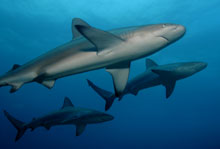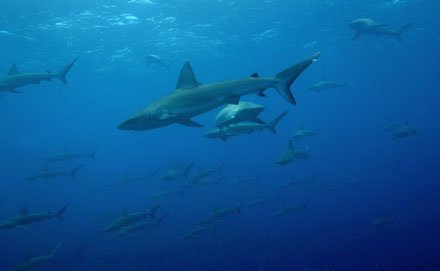NOWRAMP
2002
Counting
Sharks
Posted by Mark Heckman, Educator, Waikiki Aquarium/ University
of Hawai'i - Manoa
Underwater Photography by Jim
Watt
 One
of the main differences between the marine environment of
the Northwestern Hawaiian Islands and that of the main Hawaiian
Islands has to do with the number of predators (like sharks)
you find - big top predators (also called 'apex' predators).
Off O`ahu or the Island of Hawai`i, it is rare to see a
shark close up. In fact, it is rare to see a shark at all.
The top predators are just not around.
One
of the main differences between the marine environment of
the Northwestern Hawaiian Islands and that of the main Hawaiian
Islands has to do with the number of predators (like sharks)
you find - big top predators (also called 'apex' predators).
Off O`ahu or the Island of Hawai`i, it is rare to see a
shark close up. In fact, it is rare to see a shark at all.
The top predators are just not around.
Here
in the Northwestern Hawaiian Islands, things are a bit different.
Our dive crews see sharks routinely - one shark, two sharks,
five, ten, fifteen sharks and more (1).
This is fast becoming one of the last places on Earth to
find reef sharks. Elsewhere in the Pacific they are getting
rapidly fished out for the shark fin market. Currently,
divers and snorkelers come back from travels to even the
most remote islands in the Pacific and report that the reef
sharks are disappearing fast. With the advent of inexpensive
power boats, local (and not so local) fishing crews can
get just about anywhere.
So
let's take a look at some of the sharks we are encountering
in this last bit of protected ocean wilderness.
 Whitetip
Reef Shark
Whitetip
Reef Shark
Triaenodon obesus (Ruppell, 1837)
Hawaiian name: mano lalakea
This
shark does not need to swim to breathe; it can pump water
over the gills while resting on the bottom. Note the white
tips on the dorsal (top) and caudal (tail) fins. Quiet during
the day, these sharks are seen singly or in pairs in caves,
under ledges or in quiet spots. If they do rise up and swim
during daylight hours, the swimming is typically
slow and relaxed. These sharks are not considered a threat
to humans, although this can lead to problems as well. Swimmers
and divers now sometimes crowd around and even poke (3)
at these sharks in the wild - surely not a good choice.
At
night, however, this shark is a different animal. Sinuous
and fast, they pursue reef fish, octopus and lobsters on
the reef. Whitetip reef sharks can reach nearly 6 feet in
length, but 4 - 5 feet is more common. They may return to
the same resting spot each day for weeks or even months
if not disturbed.
 Gray
Reef Shark
Gray
Reef Shark
Carcharhinus amblyrhynchus (Bleeker, 1856)
Hawaiian Name: mano
We
began encountering the grey reef sharks on
our first dive at Nihoa Island. These sharks swim constantly,
patrolling the reef. Maximum size is about six feet, but
swimmers and divers often report that they seem much larger
(4). Gray reef sharks are famous for their
visible threat posture (unfortunately, not always used).
Grays have been observed dropping the pectoral fins down
and arching the back when their "personal" space
is invaded.
Gray
reef sharks are curious about changes in their environment.
New features or activity in their environment may mean food
(not the divers, but what ever the divers scare up). Our
divers are used to having a shark or three keeping an eye
on them as they go about their work.
 Galapagos
Shark
Galapagos
Shark
Carcharhinus glapagensis (Snodgrass and Heller, 1905)
Hawaiian Name: mano
Galapagos
sharks start appearing at Gardner Pinnacles.
They will become the more common shark as we move up the
chain. Larger than the Gray reef shark, maximum size is
to over eleven feet. When swimmers and divers encounter
these sharks and report that it was a big shark, it really
could have been a large animal. Galapagos sharks lack the
dark black edge (5) to the tail fin found
on grey sharks and have a slight ridge (5)
between the dorsal (top) and caudal (tail) fin.
Galapagos
sharks, like the Gray reef sharks, sometimes accompany our
divers as they go about their business. Numbers can range
from one, to five, to more than fifteen sharks slowly circling,
especially as the divers ascend at the end of the dive.
Expedition divers are all experienced and keep an eye on
these animals. Our crew are all instructed to abort a dive
if conditions warrant. Galapagos sharks have been known
to be aggressive, bumping or charging divers; but are typically
not an issue.
 Tiger
Shark
Tiger
Shark
Galeocerdo cuvier
Hawaiian Name: niuhi
Tiger
sharks are found throughout the Main and Northwestern Hawaiian
Island chain. These are the sharks most often implicated
in attacks (6) on humans in Hawaiian waters.
Tiger sharks are the main predator in the Hawaiian Islands
large enough to feed on turtles, seals, and on other sharks.
They are also the clean up crew. Tiger sharks will take
care of any dead animals washed down in storms, and have
been seen feeding on floating bags of trash.
In
the Northwestern Hawaiian Islands, Tiger sharks have been
observed taking newly fledged albatross chicks that land
on the water. It would seem that this would be an easy meal,
but observations have shown that they often miss, especially
in the beginning of the season. Sometimes observers of this
scenario are split between those rooting for the bird and
those rooting for the shark (they need to eat also). In
reality, sharks eat less, pound for pound, than humans or
other mammals.
 White
Shark
White
Shark
Carchcarodon charcarias
Hawaiian Name: niuhi
Current
information on White sharks shows that they can be long
distance travelers. Reliable records for the Main Hawaiian
Islands exist, with only a very few individuals seen in
any year. A recent study showed that tagged individuals
leaving California tended to move deeper into cooler waters
as they made way into the tropics.
References:
Randall, John, 1996, Shore Fishes of Hawai'i, Crow, G.L.
and Crites, J., 2002, Sharks and Rays of Hawai'i
(1)
Count the sharks in this picture, how many can you find?
Note how they just disappear into the blue. They sense us
long before we can notice them. Click here (2)
for the correct answer.

<<back
(3)
Not a good idea, even non-aggressive sharks may have lots
of sharp teeth. With all of the shark shows on television,
perhaps people are now feeling a false sense of security
with sharks. Our advice: don't feed or pet the bears in
the national parks; don't pet or poke the sharks on the
reefs. As to those sharp teeth? Sharks need them to catch
their food. Fish are slippery.
<<back
(4)
Our eyes and brain are adjusted for seeing objects through
air not water. Light travels at a slower speed through water.
This speed change, coupled with problems with reduced visibility,
causes swimmers and divers to misjudge the sizes of objects
in water. Objects in water look 25 percent larger than on
land.
<<back
(5)
On the other hand, Galapagos can have black shading (versus
a darker black edge) on the tail fin. Unless a diver is
familiar with the differences between Gray and Galapagos
sharks, it is easy to misidentify the two. And if you are
close enough to see the slight ridge between dorsal and
caudal fins - you are probably too close.
<<back
(6)
Despite local news coverage, shark attacks are not a high
risk for most people. Shark attacks in Hawai`i continue
to average at 2 - 3 a year. Given the millions of water
entries by tourists and locals each year, the odds for any
individual to have a negative encounter are extremely low.
Driving to and from the beach is a much more risky affair.
Still, sharks should always be treated with caution and
respect.
<<back
(2)
How many sharks?
Answer:
35
<<back
 Talk About It!
Talk About It!
How do sharks help marine ecosystems?
Asked by Diane from Kealakehe Elementary on Sep 29, 2002.
Why is it GOOD that there are so many sharks in the NWHI? Why is the presence of apex predators an indication of the health of the ecosystem?
Answered by Andy Collins, NWHI Coral Reef Ecosystem Reserve on Sep 30, 2002.
Sharks are a natural part of the marine ecosystem. Without apex predators, the fish that they feed on would become overpopulated and throw the whole system out of balance. Herbivores might eat too much algae, and coral eaters might eat too much reef. A healthy system is one in which all components are balanced: predators, herbivores, decomposers, and producers. What is so intriguing about the apex predator populations in the NWHI is that this is a healthy, natural ecosystem. Before, we didn't have anything to compare the reefs in the main Hawaiian Islands to, since we didn't know what a natural reef looked like! Now we can theorize that the main Hawaiian Island reefs used to look like the NWHI reefs. In fact, they probably had more productive reefs because there are more nutrients, as well as more estuaries and other productive areas. In general, sharks just have a bad reputation, and as a person who dove with over 100 sharks at Maro Reef, I can say that their reputation is undeserved.